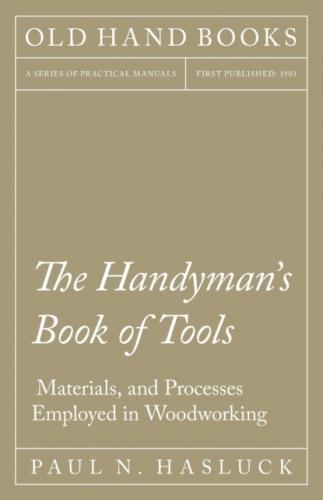Fig. 55.—Mitre Sawing Block.
Fig. 56.—Section of Mitre Block.
Fig. 57.—Inclined Mitre Sawing Block.
COMBINATION SHOOTING-BOARD
Notwithstanding the large number of patented mitring machines in the market, skilled joiners, when any particularly good piece of work is in hand, still prefer to use the ordinary home made wooden shoot. The machines, whilst new and in good condition, are undoubtedly the more expeditious in use, but if carelessly handled they are apt to get out of order, and then their work is far from satisfactory; whilst the wood shoot will stand a deal of rough usage, and is also easily repaired. Figs. 63 to 67 illustrate several improvements on the old form of shoot. A mitre-shoot, square-shoot, and joint-shoot are combined in the one board, which will prove very handy where these appliances are wanted only occasionally. The shoot consists of a top board of seasoned yellow deal 3 ft. by 9 in. by 1 1/2 in., slot-screwed to an under-frame of teak, made up of the plane bed B, 3 ft. by 2 3/4 in. by 1 1/2 in., into which are framed three cross rails 2 1/4 in. by 1 in. flush on the under-side. This frame is shown in plan and in section respectively in Figs. 65 and 66. In the centre of the top board is the mitre-block, a piece of dry oak 2 in. thick cut with two of its sides exactly square with each other, and at an angle of 45° with the third. This block, instead of being fixed in the usual way, is mounted on a pivot in its centre, as shown at B (Figs. 63 and 64), and is capable of adjustment either as a mitre-shoot, as shown in the full lines, or as a square-shoot, as indicated by the dotted lines in Fig. 63; it is firmly secured in either position by means of three 1/2-in. by 3-in. square-head screw bolts similar to Fig. 68. The grain of the block should run parallel with the plane bed, then shrinkage will not alter its shape. The board is arranged for jointing by removing the mitre-block and working the boards against the adjustable stop A. This stop, which is shown in perspective also at Fig. 69, works in art undercut groove, and is secured in any required position by the screw bolt; the projection at the end prevents the boards, slipping whilst being planed.
Fig. 58.—Mitre Box.
Fig. 59.—Mitre Box with Strengthening Piece.
Fig. 60.—Mitre Box with Strengthening Pieces.
Fig. 61.—Mitre Shooting Block with Solid Base.
Fig. 62.—Mitre Shooting Block with made-up Base.
Fig. 63.—Combination Shooting Board.
Fig. 64.—End Elevation of Combination Board.
DONKEY’S-EAR SHOOTING BLOCK.
A “donkey’s-ear” is used for mitreing or bevelling the edges of wide but thin material, with the cut at right angles to that adopted for stouter mouldings. Fig. 70 gives an idea of its form and construction. Fig. 71 shows another handy form of mitre-shoot for wide surfaces that have to be edge-mitred. This also is known as a “donkey’s-ear,” and it consists of a rest A for the material to be mitred, a bed B for the shooting plane, a guide C for the plane, and a frame D for the purpose of elevating the appliance to a convenient height by fixing it in the bench-screw or to the tail of the bench. The rest A is made of a piece of deal 1 ft. 3 in. long, 4 1/2 in. deep, and 3 in. thick, and has a rebate run along two of its edges (see the section), Fig. 72. The bed B should preferably be of teak, as this wood is of a greasy nature and does not cast. It should be about 2 ft. long, 3 in. wide, and 2 in. thick. The guides C are 1 in. thick, and project about 1/2 in. above the bed. The frame D is made up of 3-in. by 1-in. deal, and tenoned through the bed with barefaced tenons, with shoulders towards the rest.
Figs. 65 and 66.—Frame of Combination Board.
Fig. 67.—Elevation of Combination Board.
Fig. 68.—Screw-bolt.
Fig. 69.—Adjustable Stop.
MITEE TEMPLATES.
Of constant use as an aid in cutting mitres is a mitre template, which is made from a piece of hard wood, in the form shown by Fig. 73; it is usually about 4 in. long, 3 in. wide each way, and 1/2 in. thick. It is made by planing up true a square block of hard wood, cutting out a rebate B, and making a “true mitre” (458) upon each end, as shown. If an ordinary cupboard framing is examined at the junction of the rail with the jambs, it will be seen that each of the moulded edges has been mitred as shown in Fig. 74. To obtain this mitre, the template is used, as Fig. 75. Fig. 76 shows the template applied to the edge being held by the left hand, whilst the right guides the chisel A.
Fig. 70.—Donkey’s-ear Shooting Block.
Fig.
